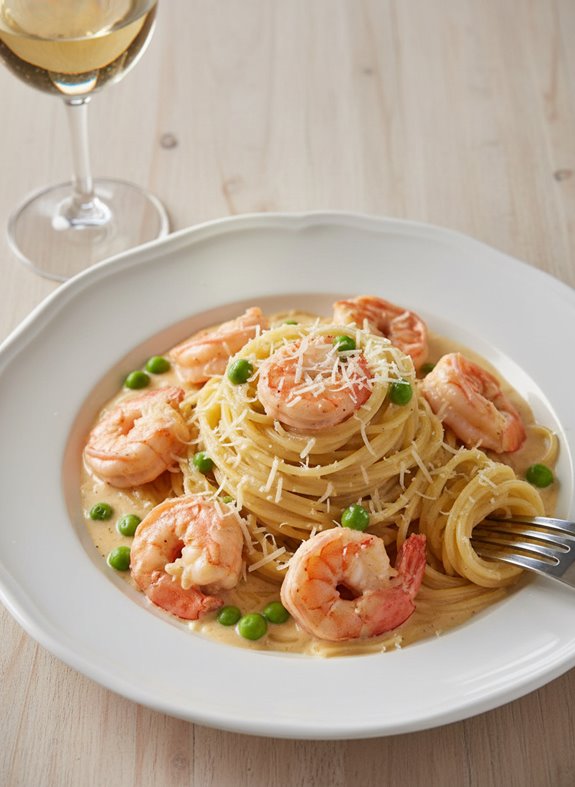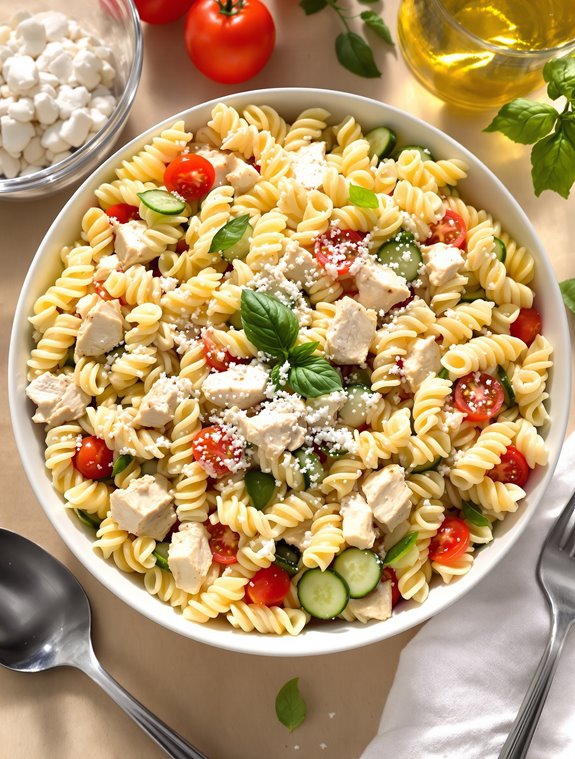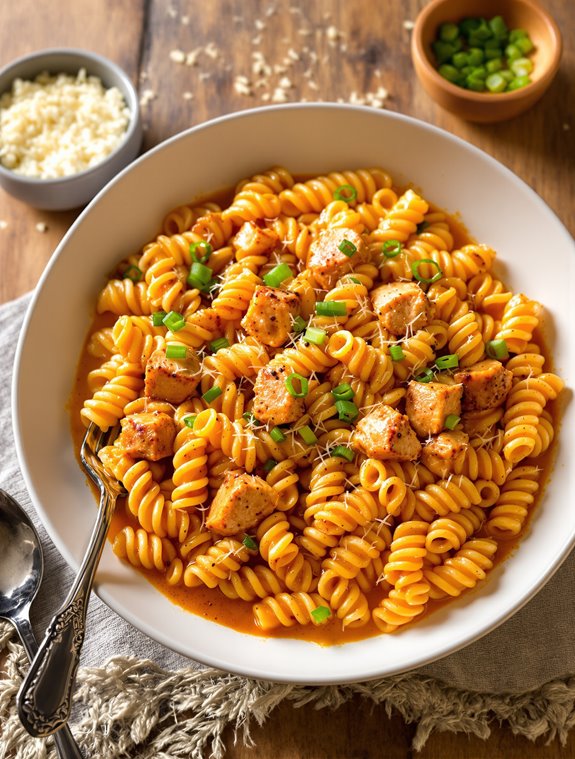Why You’ll Love this Authentic Korean Japchae
If you’ve never tried authentic Korean japchae before, you’re in for a real treat that will transform your dinner table.
These silky sweet potato starch noodles soak up all the savory-sweet flavors while mingling with colorful veggies and tender beef.
I love how this dish balances textures perfectly—chewy noodles, crisp-tender vegetables, and that hint of sesame oil that ties everything together.
The best part? It’s impressive enough for guests but simple enough for weeknights.
Ever noticed how the best recipes are both comforting and exciting? Japchae is exactly that.
A feast for the eyes and the palate. Perfect hot or cold, too.
What Ingredients are in Authentic Korean Japchae?
To make authentic Korean japchae, you’ll need a combination of chewy sweet potato starch noodles (the star of the show), protein, and a colorful array of vegetables. The magic happens when these simple ingredients come together with a savory-sweet sauce that coats every strand of noodle and veggie. I can’t get enough of how the sesame oil adds that distinctive nutty aroma that makes this dish unmistakably Korean.
- 150g Korean sweet potato starch noodles (dangmyun)
- 150g beef, thinly sliced
- 1 bunch spinach
- 1 medium carrot, cut into thin matchsticks
- 1 medium onion, thinly sliced
- 5 dried shiitake mushrooms
- 2 cups sliced white mushrooms
- 3 garlic cloves, minced
- 7-8 green onions, cut into 7cm pieces
- 4 tablespoons soy sauce (divided)
- 4 tablespoons sesame oil (divided)
- Olive oil (for stir-frying)
- 3 tablespoons sugar
- 1 teaspoon pepper
- 1 tablespoon toasted sesame seeds
While the ingredient list might seem long, don’t be intimidated—many of these items are probably already in your pantry. For the most authentic flavor, try to find real Korean dangmyun noodles at an Asian market rather than substituting with other types of glass noodles. The beef is technically optional, so vegetarians can easily skip it and still create a delicious meal. And if dried shiitake mushrooms aren’t available, you could use all fresh mushrooms in a pinch, though you’ll miss some of that deep umami flavor that makes japchae so crave-worthy.
How to Make this Authentic Korean Japchae
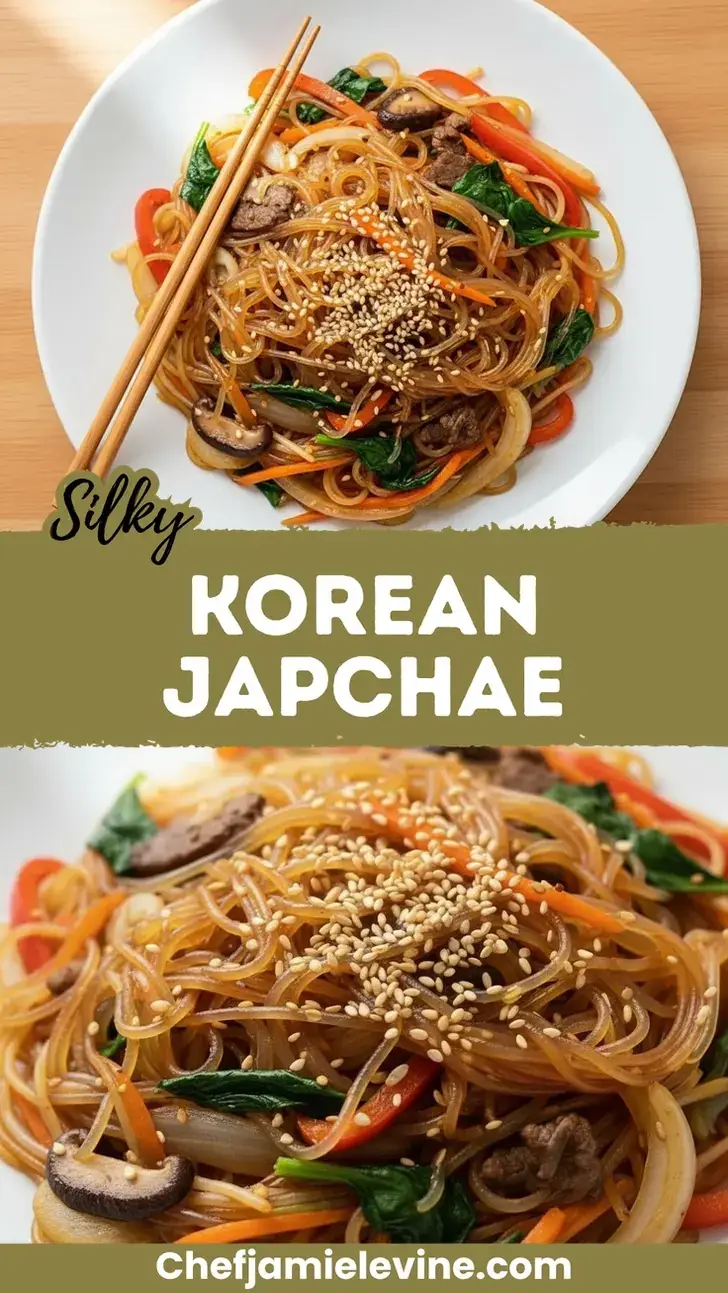
Making japchae starts with proper preparation of the noodles and vegetables. First, soak your 5 dried shiitake mushrooms in warm water for several hours until they’re soft and pliable. Once they’ve absorbed enough moisture, squeeze out the excess water and slice them thinly.
Meanwhile, boil 150g of Korean sweet potato noodles (dangmyun) for about 3 minutes until they’re soft but still slightly chewy. I’ve found that testing one strand is the best way to check if they’re done—when it feels tender between your teeth, they’re perfect. Drain the noodles, transfer them to a large bowl, and immediately cut them into more manageable lengths using scissors. Toss with 1 tablespoon each of soy sauce and sesame oil to prevent sticking and begin the flavoring process.
The key to authentic japchae is cooking each vegetable separately to maintain its distinct texture and color. Using the same pot of hot water from the noodles, blanch 1 bunch of spinach for just a minute, then rinse it in cold water three times to stop the cooking process and preserve its vibrant green color.
After squeezing out excess moisture, cut the spinach into 5cm pieces and season with 1/2 tablespoon each of soy sauce and sesame oil. Next, in a heated pan with just a few drops of olive oil, quickly stir-fry your carrot matchsticks for 30 seconds, followed by your thinly sliced onion until translucent, then the sliced white mushrooms, and finally the green onions. Each vegetable gets its own turn in the pan, cooking just long enough to soften slightly while maintaining some crispness.
For the final components, stir-fry your beef strips (if using) with the prepared shiitake mushrooms until well-cooked, then add 3 minced garlic cloves, 1/2 tablespoon soy sauce, and 1/2 tablespoon sugar for the last 30 seconds of cooking.
Now comes the most satisfying part—combining everything in your large bowl and seasoning with the remaining 2 tablespoons soy sauce, 3 tablespoons sugar, 2 tablespoons sesame oil, and 1 teaspoon ground pepper. Mix thoroughly so every noodle and vegetable gets coated in that savory-sweet sauce, then sprinkle 1 tablespoon of toasted sesame seeds over the top.
The result? A gorgeous, colorful dish with perfectly balanced flavors that’s as beautiful as it’s delicious.
Authentic Korean Japchae Substitutions and Variations
While authentic japchae relies on specific ingredients for its traditional flavor profile, you can make several practical substitutions without compromising the dish’s essence.
No sweet potato starch noodles? Regular rice noodles work in a pinch, though they’ll have a different texture.
Vegetarians can skip the beef and double up on mushrooms—portobello makes a hearty replacement. Can’t find shiitakes? Button mushrooms are perfectly fine, really.
For a spicier kick, I sometimes add gochujang (Korean chili paste) to mine. My grandmother would probably raise an eyebrow, but hey, cooking evolves.
What to Serve with Authentic Korean Japchae
Japchae might be a star on its own, but pairing this colorful Korean noodle dish with complementary sides elevates it from a simple meal to a proper feast.
I love serving mine with kimchi, which adds that perfect tangy, spicy contrast to the sweet-savory noodles.
A protein-rich banchan like gamja jorim (braised potatoes) or spicy cucumber salad creates balance. For a traditional approach, add bulgogi if you haven’t already mixed it into your japchae.
When I’m hosting, I’ll complete the spread with steamed rice and clear doenjang soup.
The rice soaks up extra sauce—heaven for those of us who chase every last flavor.
Final Thoughts
After mastering this authentic japchae recipe, I’ve come to appreciate how this beloved Korean dish beautifully balances flavors, textures, and colors in one spectacular meal.
The slightly chewy glass noodles, tender vegetables, and savory beef create a harmony that’s truly greater than the sum of its parts.
What I love most? The way sesame oil transforms everything it touches, giving japchae its distinctive nutty aroma.
Don’t stress if your first attempt isn’t picture-perfect. Mine certainly wasn’t.
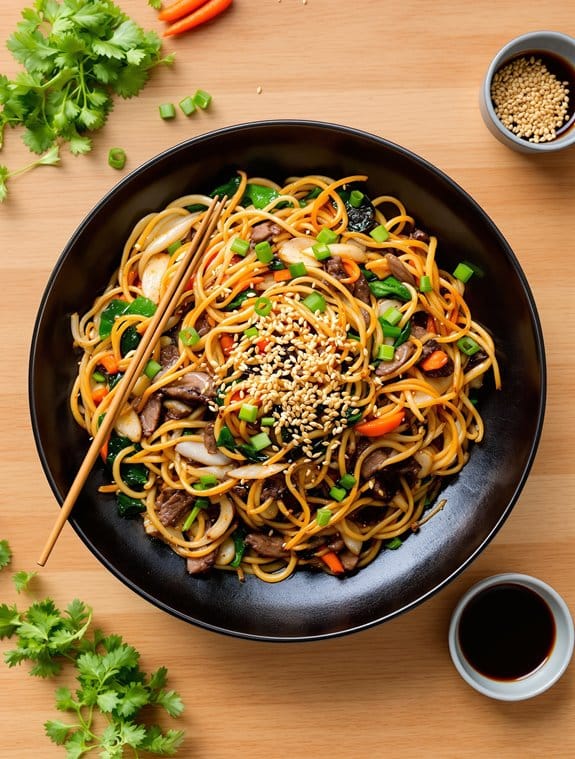
Korean Japchae: Silky Stir-Fried Noodles
Ingredients
Equipment
Method
- Soak dried shiitake mushrooms in warm water for several hours until soft and pliable. Once softened, squeeze out excess water and slice thinly.
- Boil the sweet potato noodles for about 3 minutes until soft but still slightly chewy. Drain and transfer to a large bowl.
- Cut the noodles into more manageable lengths using scissors. Toss with 1 tablespoon each of soy sauce and sesame oil to prevent sticking.
- Using the same pot of hot water, blanch the spinach for just 1 minute. Rinse in cold water three times to stop cooking and preserve color.
- Squeeze excess moisture from spinach, cut into 5cm pieces, and season with 1/2 tablespoon each of soy sauce and sesame oil.
- Heat a pan with a few drops of olive oil and stir-fry carrot matchsticks for 30 seconds. Remove and set aside.
- In the same pan, stir-fry sliced onion until translucent. Remove and set aside.
- Stir-fry the sliced white mushrooms until softened. Remove and set aside.
- Quickly stir-fry the green onions until slightly wilted. Remove and set aside.
- Stir-fry beef strips with prepared shiitake mushrooms until well-cooked. Add minced garlic, 1/2 tablespoon soy sauce, and 1/2 tablespoon sugar for the last 30 seconds of cooking.
- Combine all cooked ingredients in the large bowl with noodles. Season with remaining 2 tablespoons soy sauce, 2 tablespoons sesame oil, remaining sugar, and pepper.
- Mix thoroughly until all ingredients are well coated with the sauce. Sprinkle with toasted sesame seeds before serving.

